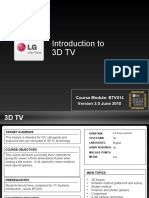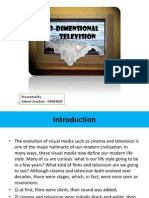0% found this document useful (0 votes)
76 views7 pagesIntroduct: Ion To How 3-D TV Works
1) 3-D TV uses glasses and technology to trick the brain into perceiving depth from a flat screen by showing each eye a different image.
2) Passive glasses use colored lenses or polarization to filter images so each eye sees a separate set. Active glasses have LCD lenses that alternately block each eye's view synchronized with alternating images on the screen.
3) For active glasses to work, a TV must have a high refresh rate and stereoscopic sync signal connector to synchronize the glasses with images displayed. Compatible glasses, emitter, content, and connections are needed to view 3-D with active glasses on a 3-D-ready TV.
Uploaded by
SANCHIT_SHERAMKARCopyright
© Attribution Non-Commercial (BY-NC)
We take content rights seriously. If you suspect this is your content, claim it here.
Available Formats
Download as DOCX, PDF, TXT or read online on Scribd
0% found this document useful (0 votes)
76 views7 pagesIntroduct: Ion To How 3-D TV Works
1) 3-D TV uses glasses and technology to trick the brain into perceiving depth from a flat screen by showing each eye a different image.
2) Passive glasses use colored lenses or polarization to filter images so each eye sees a separate set. Active glasses have LCD lenses that alternately block each eye's view synchronized with alternating images on the screen.
3) For active glasses to work, a TV must have a high refresh rate and stereoscopic sync signal connector to synchronize the glasses with images displayed. Compatible glasses, emitter, content, and connections are needed to view 3-D with active glasses on a 3-D-ready TV.
Uploaded by
SANCHIT_SHERAMKARCopyright
© Attribution Non-Commercial (BY-NC)
We take content rights seriously. If you suspect this is your content, claim it here.
Available Formats
Download as DOCX, PDF, TXT or read online on Scribd
/ 7























































































